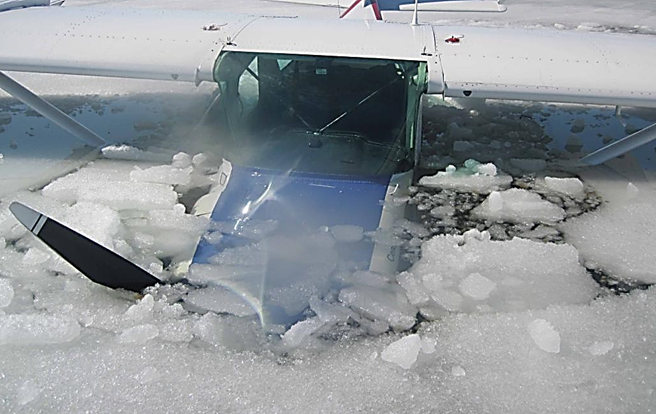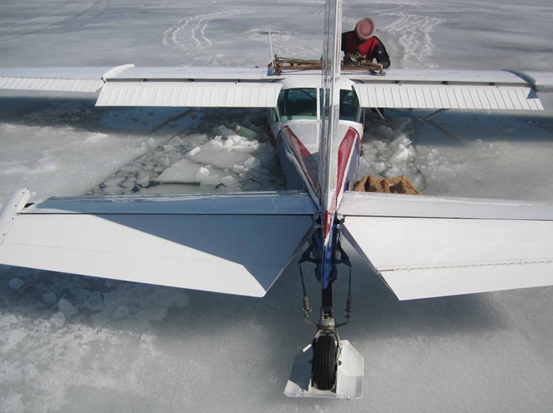by Bryan Webster and Kevin Elwood, Aviation Egress Training Systems
Semi-submerged plane through the ice
Preparing for a winter flight starts with being properly dressed in the morning before you head to the airport. There is nothing worse than finding yourself in adverse conditions and being ill-prepared once it’s too late.
Passengers’ survival when faced with an emergency could depend on the thorough briefing received earlier from you, the pilot, to ensure their safety during all private or commercial flights.
Seriously consider your passengers’ clothing upon arrival previous to a departure as they may not be properly dressed for that day’s weather conditions.
Depending on geographical locations across Canada, conditions could include sub-zero temperatures in excess of −40°C until spring returns.
Understand that all persons on board become the pilot’s responsibility in the unlikely event you find yourselves stranded, for any reason, in adverse conditions.
In order to dramatically improve survivability during these events, clear thinking and having additional resources on board the aircraft is the answer. A lack of proper winter clothing, including gloves, toques, and footwear, could be the difference between an uncomfortable experience in the wilderness and a real-life survival episode until help eventually arrives.
West Coast pilots and passengers who fly year-round could possibly find themselves standing on a shoreline, soaking wet, and awaiting rescue.
Although temperatures may not be life-threatening, it could be one or more long, cold nights if there is not any dry wood or the ability to light a fire.
One idea is to keep a space blanket, lighter, and anything else you feel is necessary along with the personal floatation device (PFD), which has saved the day in a few cases.
Another consideration would be finding yourself and possibly any number of passengers on top of an inverted set of floats with the aircraft hanging below.
Semi-submerged plane through the ice
At some point, you must decide the best course of action: whether to stay with the somewhat precarious vessel or swim to a nearby shore until help arrives.
Water temperature and swimming distance are the two key decision factors when weighing the options.
Today, all commercial seaplane flights with nine passengers or less on board must be wearing a PFD, including the pilot, so at least the concern over drowning en route has diminished.
Depending on the time of year (early spring thaw after the ice has gone out) or the body of water (Atlantic Ocean) and the temperature, time to function effectively could be limited to only a few minutes.
Also understand that when your emergency locator transmitter (ELT) is submerged in water, it is no longer capable of sending out a distress signal. In most cases, the antenna is on the back of the aircraft, and therefore would be pointing to the bottom of the lake, river, or ocean.
Northern operators may find themselves subjected to bitterly cold winds while huddling on a wide-open frozen lake in harsh conditions, which could cause frostbite or worse.
Both spring and fall for any ski-equipped aircraft offer a host of perils. For example, simply falling through thin ice unable to support the weight of the aircraft. Cold water will quickly rush in and the wings may be the only thing supporting the aircraft and preventing it from sinking, thus forcing all the occupants to depart upward, as the doors could be blocked.
Failing that, a front or back window may be the only way out. In many instances, there is an escape hatch installed in the ceiling of De Havilland products to alleviate this concern.
An extra layer of security may be to carry an additional tracking system as a private operator—similar to most commercial aircraft that are flight followed by their office staff.
In any event, winter conditions demand far more thought as to how pilots must plan their flights compared to any other time of the year.
For further information on this subject, consult one of the numerous books or Internet resources where this material is readily available.
Note to all commercially rated seaplane pilots: Please be advised that as of March 6, 2023, you must be water egress trained as per Canadian Aviation Regulations (CARs) 703.98(2)(c.1) and 704.115(2)(a.1).

